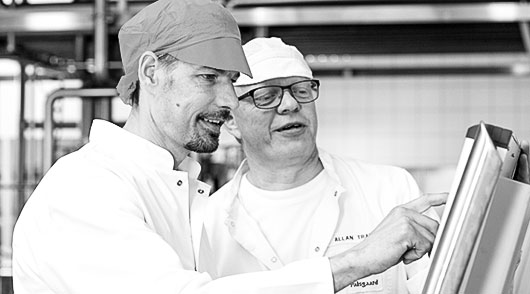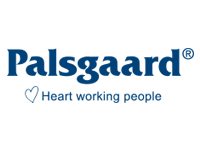“Production scheduling in the food manufacturing industries entails a wide array of very specific challenges for the planner” – Hans Jørgen Lynggaard, co-creator of ROB-EX and Managing Director of ROB-EX.
Manufacturers of food, medical products, chemicals etc. often operate with batches. There will be aspects of both production to order and production to stock – and food manufacturers often operate with process manufacturing. Process manufacturing demands scheduling tools that are specifically designed for this type of production. Other typical challenges facing food manufacturing companies include: production lines with many variants on each line, CIP, physical limitations in production, fluctuating demand, load balancing, and handling of possible allegens.
Food manufacturers face new and ever stricter regulations, and scheduling must take these into account. ROB-EX maintains a continuous dialogue with the customers in the food industries, to maintain its position as a supplier of a system that provides tools and features that reflect the actual developments and needs in the sector.
Overview is key for Palsgaard A/S
Supply Chain Coordinator, Christina Elstrøm Jensen, Palsgaard A/S tells us that the company has used ROB-EX for 5 years now. She highlights the overview provided and the immediate visual presentation of the consequences of all scheduled activities, as some of the greatest benefits that can be obtained by food manufacturing companies, such as Palsgaard. She continues:
“The overview provided by ROB-EX enables us to be more precise in the offering of delivery times to customers – we also save time, and as we all know, time is money. Production is much more flexible today, and we are able very quickly to determine e.g. whether we have capacity to take in rush orders or not. ROB-EX makes it much easier for us to manage our many semi-manufactured products. We receive a lot of raw materials on trucks, and we package finished goods of a variety of shapes and forms, e.g. pellets, blocks / cakes, powder or liquids that are shipped in plastic jerrycans, drums or road tankers.”
Palsgaard A/S emulsifiers and stabilisers are developed and produced for e.g. food manufacturers, bakeries, dairies and for products such as salad dressing, cosmetics etc. Palsgaards A/S has 5 planners and a total of 420 employees (of which 285 are employed in Juelsminde, Denmark)
Key challenges: shelf life, storage and allergens
Product shelf life is the primary concern in some of the production areas:
“We have deadlines that must be kept to a tee, and products that must progress through production within fixed time frames. We have restrictions relating to shelf life and storage capacity. We have storage volumes of up to 130 tonnes. With such large volumes, it is critical that we meet deadlines – should we fail to do so, the consequences are enormous,” Christina Elstrøm Jensen says.
In other areas of production, the main issue is allergens. One production plant operates with as much as 6 allergenic groups that must be processed in a fixed sequence, to avoid carry-over. ROB-EX provides a full overview of the allergens – it is easy to determine which products that belong in a given allergenic group.
“Products are processed in segregated stages, and today production has a full overview of when they need to move the product from one group to the next – and when they need to carry out extra cleaning cycles. There will always be residue left in the machines – we cannot get around this fact by simply introducing fixed sequencing. However, the consequences of carry-over are carefully monitored and controlled,” Christian Elstrøm Jensen explains.
Multiple product variants and product lines
Christina Elstrøm Jensen says: “Palsgaard operates with multiple product lines, and ROB-EX makes the connections between them visible. We transport products from one production area to another, and if we fall behind schedule, we are immediately able to see the consequences of the delay for the second area. This makes it possible to make qualified decisions about how we can mitigate any delays. Some products must leave the production area within 8 hours – this makes it absolutely necessary to have a clear overview of the consequences all way round.
We try to pre-empt problems. ROB-EX helps us predict a lot of the potential problems so that we are able to avoid downtime, changeovers and extra cleaning. It really is important to be able to predict potential problems, and to act promptly by initiating pre-emptive measures”
Christina Elstrøm Jensen explains: “ROB-EX makes it possible to see the consequences of various scenarios, so that we can schedule activities optimally. If we predict delays, we are able to handle these more efficiently. We are also able to reallocate the employees affected by the delay. We are simply much better prepared now. Scheduling is like a jigsaw puzzle – you constantly pull the bits apart and reorganise them, in order to make them fit more neatly together.”
A viewable plan: access for all relevant areas in the company
“Every morning, purchasers, planners and production have look at the plan together, to see if the scheduled activities are on track. They quickly get a full and diagrammatic overview of the status in production – and all relevant people in the company have access to the monitor.
-In production they are able to view the scheduled orders and to keep updated on changes in the plan. Our production staff are very happy with their Viewer access – now they are always fully updated on the products that are scheduled for production, and they are able to have more of a say as regards their daily work. The contributions from our production staff result in more efficient scheduling. They are able to use their experience and knowhow to make suggestions for the practical execution of orders, e.g. by suggesting a change in the sequencing of operations that may save us a cleaning cycle,” Christina Elstrøm Jensen says.
ROB-EX has just released the new ROB-EX 6.2, and Christina Elstrøm Jensen looks forward to utilising the new features:
“The new feature “Campaigns” makes it possible to operate with groupings of groups of products, lock the period and then finish the campaign. This means that we are able to skip a cleaning cycle, e.g. when we run products for ice cream. Finding ways of reducing the required number of cleaning cycles is a big deal in a company such as ours,” Christina Elstrøm Jensen concludes.


